
 HMS WALKER
HMS WALKER
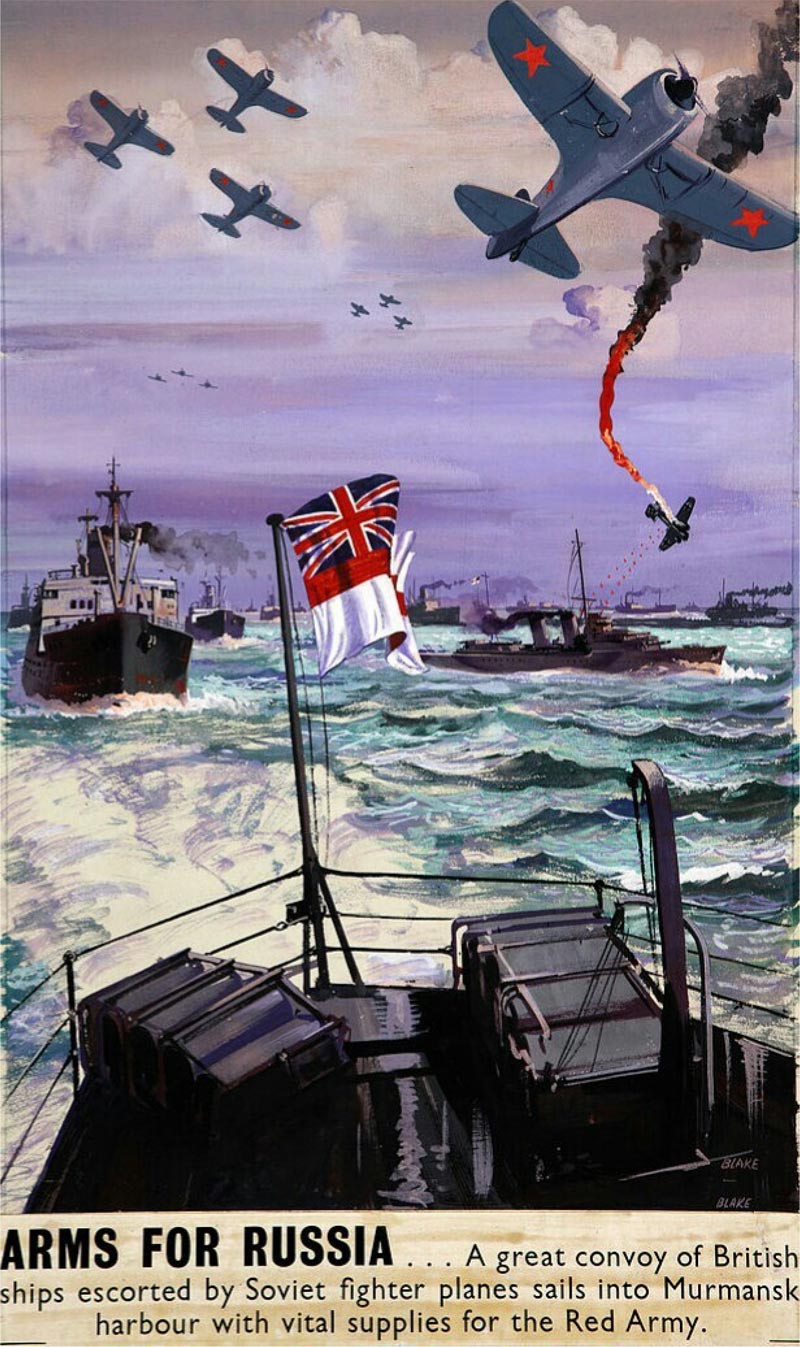
Arctic Convoys: Part 1
When Lt Cdr. Arthur Nichol Rowell RN - "Hooky Walker" - was CO 1943-4
|
|
JW.57 RA.57 JW.58 RA.58 RA.59 JW.61 RA.61 JW.63 RA.63 |
Lt.Cdr. Arthur Nichol Rowell, RN in command Departed Liverpool 20 February and arrived Kola Inlet on 28 February 1944. Departed Kola Inlet on 2 March and arrived Loch Ewe on 10 March 1944 Departed Liverpool 27 March and arrived Kola Inlet on 4 April 1944. Departed Kola Inlet on 7 April and arrived Loch Ewe on 14 April 1944 Departed Kola Inlet on 28 April and arrived Loch Ewe on 6 May 1944 Lt Cdr Tony Trew, SANF(V) in command
Departed Liverpool 20 October 1944 and arrived Kola Inlet on 28th October 1944 Departed Kola Inlet on 2 November and arrived Loch Ewe on 9 November 1944 Departed Liverpool 20 December and arrived Kola Inlet on 8 January 1945 Departed Kola Inlet on 11 January and arrived Loch Ewe on 21 January 1945 |
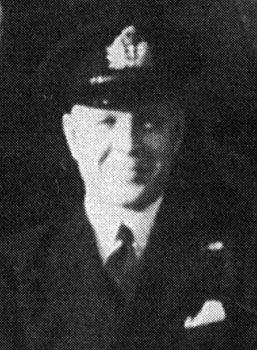 Lt Cdr Tony Trew SANF(V)
29 September - May 1945 |
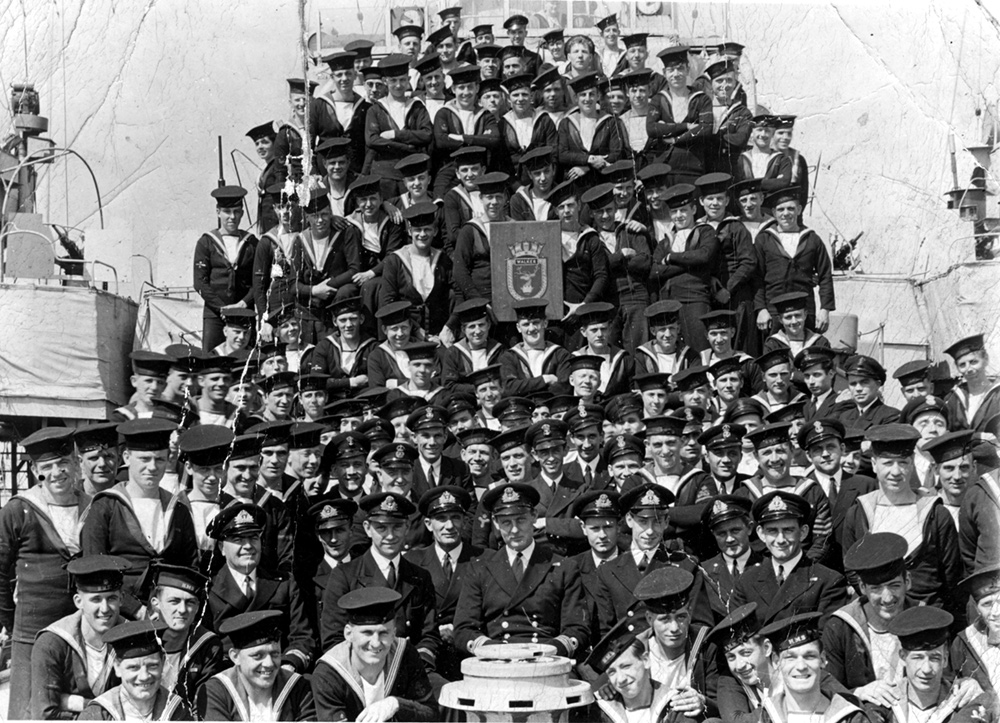
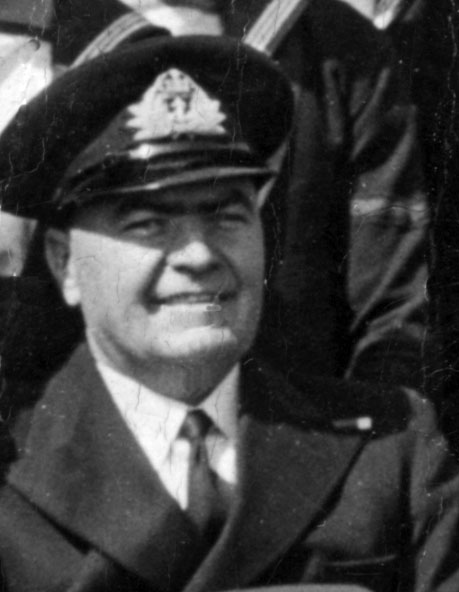 Cd Eng G.F. Osborne RN
9 March 1939 - Oct 1943 |
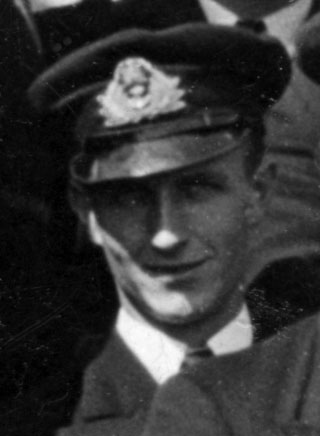 Sub Lt Eric R. Lawson RNVR
May 1943 - May 1945 |
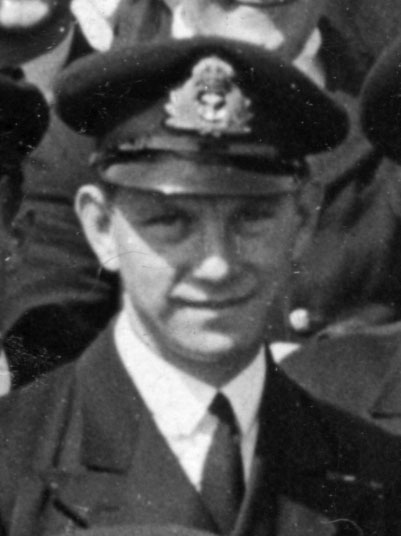 1st Lt Peter D. Sturdee RN
9 March 1943 - August 1944 |
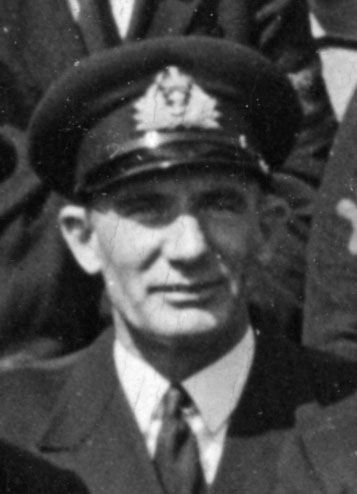 Unidentified
|
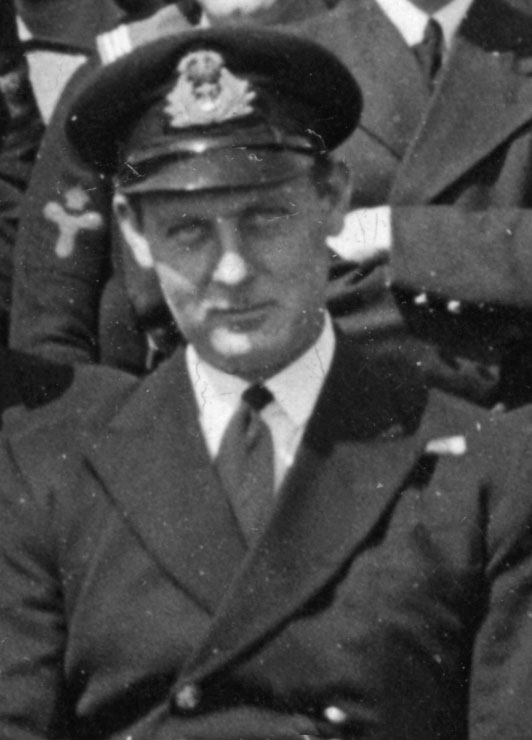 Lt Cdr. Arthur N. Rowell, RN
April 1943 - 28 Sept 1944 |
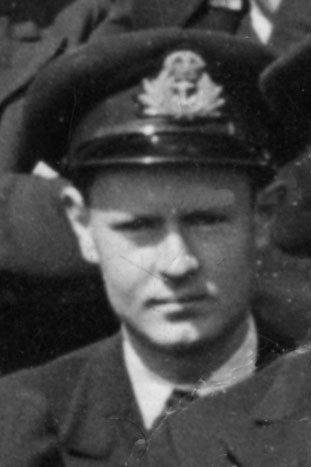 Lt James J. Glossop RN
20 May 1943 - Aug 1944 |
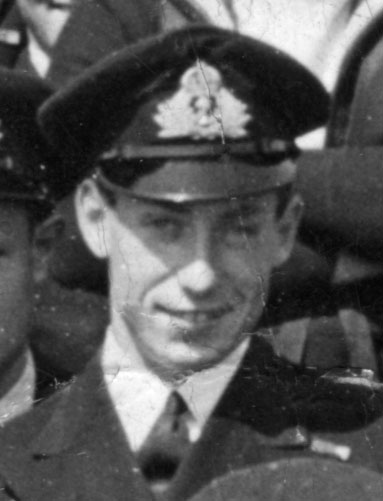 Lt A.D. "Sandy" Powell RNVR
20 March 1944 - April 1945 |
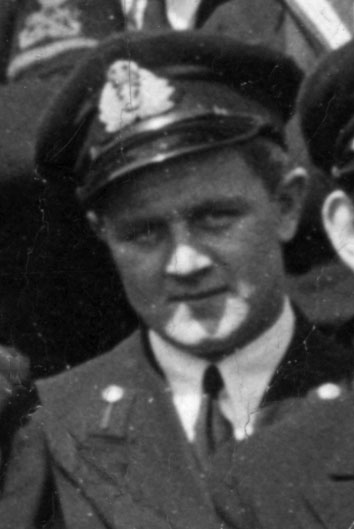 |
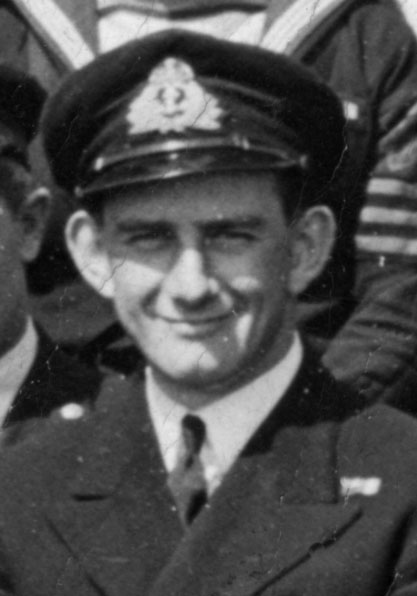
Surg Lt J.C. Macauley RNVR
20 June 1943 - Sept 1944 |
|
Lt R W D Bray RN (14 Jan 1941 - Feb 1945) Sub Lt (E) R.R. Brooks RCNVR (14 Oct 1943 - March 1945) Lt (E) E.C.Y. Hughes SANF(V) (18 March 1944 - Jan 1945) Tp Sub Lt Eric Randolph Lawson RNVR (May 1943 - May 1945) Tp Sub Lt R B Mann RNR (17 April 1941 - Feb 1945) |
Tp Sub Lt A H B McClatchley RNVR (25 June 1942 - Feb 1945) Tp Gnr (T) A W Norish RN (15 February 1943 - March 1945) Cd Eng G F Osborne RN (9 March 1939 - Oct 1943) Tp Sub Lt D Payne RNVR (21 June 1943 - March 1944) Lt Frederick V Robinson RCNVR (13 Oct 1943 - 27 Feb 1944) MPK |
Their first CO, Lt Cdr. Arthur Nichol Rowell,
was Royal Navy, the second "wavy navy", a South African, Lt Cdr A.F. Trew SANF(V). HMS Walker
"worked up" in Scotland and was then sent to Londonderry, her base for escort duties to
Gibraltar. By April 1943 the shore base at Londonderry, HMS
Ferret, was responsible for
149 escort and anti-submarine patrol vessels, two thousand shore-based
personnel and twenty thousand British and Canadian seamen. Derry provided much needed rest and relaxation to Allied sailors
following convoy duty. On one occasion while escorting a convoy to Gib Walker ran out of fuel and had to go into
Azores, a neutral country, to refuel.
In January 1944 they went to Gairloch on the Clyde to be fitted out with cold weather gear for escorting Arctic Convoys. From now on their base was Greenock (HMS Orlando) on the Clyde. HMS Walker with HMS Keppell, Beagle and Boadicea formed the 8th Escort Group, part of the Close Escort for convoys to the Kola inlet in north Russia. In overall command was Vice-Admiral F Dalrymple-Hamilton RN, the Flag Officer of the 10th Cruiser Squadron in HMS DIadem. The convoys of merchant ships formed up in Loch Ewe, a deep enclosed sea loch on the west coast of Scotland. HMS Walker would escort ships from Liverpool and the Clyde to the assembly point at Loch Ewe. Bill Perks and Albert Foulser were on five Arctic Convoys (JW57.JW58, JW59, JW61 and JW63 plus the return convoys with the prefix RA) to Polyarnoe, the Russian naval base near Murmansk on the Kola inlet from 1944 to early 1945. Click on the links in the table at the top of this page to see the names of the merchant ships and the escorts in each convoy.
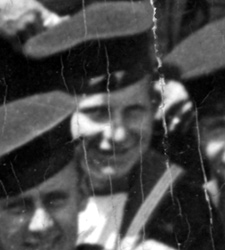
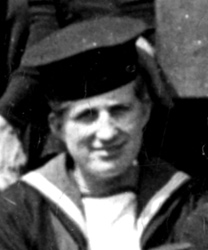
Leslie William Perks (right) was born on 31 March 1925 at Leamington Spa and iived there all his life. He left school at 14 and became a despatch rider with the National Fire Service. He was a a few months short of his eighteenth birthday when he decided to join the RAF but was told to come back when he was older so he joined the Navy instead. He did ten weeks basic training at HMS Ganges and going up the mast in the early morning was "a frightening experience". He had to prove he could swim by putting on a big "duck suit" and floating in the pool for three minutes before he was allowed to go on the ferry to Harwich. If you couldn't swim you had to go to Ipswich for an evening out. He was sent from the depot at Chatham to Tobemory for an Asdic course but they were all "ping happy" so he deliberately failed the course. On returning to Chatham he joined HMS Walker as an OD at the start of her new Commission after conversion to a Long Range Escort (LRE). He died on Bank Holiday Monday in May 2016.
They were shipmates and close friends on Atlantic Convoys to Gibraltar and Arctic Convoys to Murmansk until Walker was paid off at Barrow in Furness at the end the war. They next met at the Cenotaph in 2005 when they were awarded the Arctic Emblem and heard their names called out. The photographs were taken by Albert Foulser whose parents bought him a Box Brownie camera in 1932 for 5/-. He was the only man with a camera on the lower deck and he gave copies of the photographs he took to his shipmates including Bill Perks. Albert took all the photographs on this page apart from the photographs of the ships company which were taken by a Royal Navy photographer. Albert Foulser is standing alongside Bill Perks in both these photographs. They were both long term members of the V & W Destroyer Association and I met them at annual reunions most years. I interviewed Bill Perks at the V & W reunion at Eastbourne in 2014 and Albert Foulser at St Ives near Cambridge in 2016.

Bill
Perks, as a young rating in 1944 and wearing his Arctic Star in 2014,
and a photograph of the Kola Inlet near Murmansk in Arctic Russia taken
from HMS Walke
Courtesy of Albert Foulser
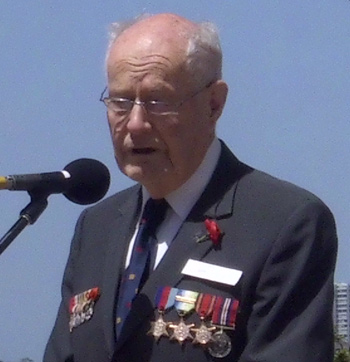
 Lt Cdr James J Glossop RN had joined HMS Walker
as a Sub on 20 May 1943 when Lt.Cdr. Arthur Nichol Rowell, RN was the
CO and was promoted to Lieutenant on 16 May 1944 and retired from the
Royal Navy as a Lieutenant Commander in 1968. He took part on Arctic Convoys JW.57 and JW.58 and the return convoys described by ABs Albert Foulser and Bill Perks.
Lt Cdr James J Glossop RN had joined HMS Walker
as a Sub on 20 May 1943 when Lt.Cdr. Arthur Nichol Rowell, RN was the
CO and was promoted to Lieutenant on 16 May 1944 and retired from the
Royal Navy as a Lieutenant Commander in 1968. He took part on Arctic Convoys JW.57 and JW.58 and the return convoys described by ABs Albert Foulser and Bill Perks. 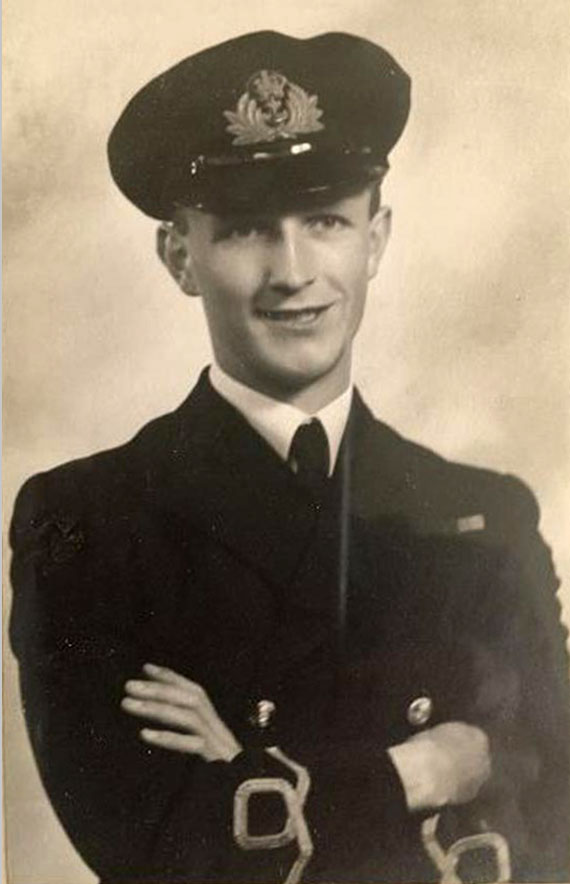
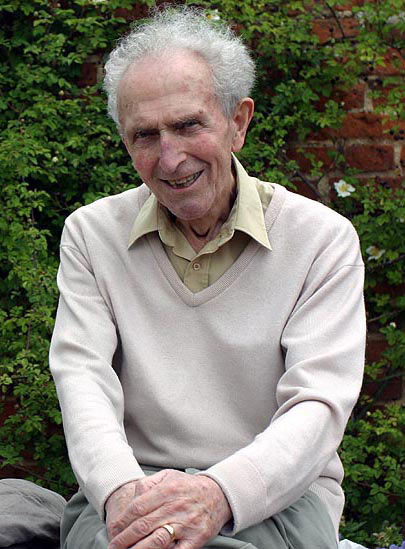 Sub
Lt Eric R Lawson was identified by his son, David Lawson, who provided
the photograph of him with the single stripe of a Sub Lt in the "Wavey
Navy", the RNVR. Click on the image to view full size in a separate
window. David Lawson wrote this brief account of his father's life
based on personal memories, his service certificate and the
"chitties" signed by his Conmmanding Officers:
Sub
Lt Eric R Lawson was identified by his son, David Lawson, who provided
the photograph of him with the single stripe of a Sub Lt in the "Wavey
Navy", the RNVR. Click on the image to view full size in a separate
window. David Lawson wrote this brief account of his father's life
based on personal memories, his service certificate and the
"chitties" signed by his Conmmanding Officers: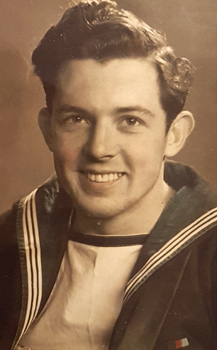 Donald
Frank Wright (left) was born at Norwich on 8 August 1925. He was living at
home with his father and working as an "errand lad" when he
volunteered to join the Royal Navy on 15 February 1943 "for the period
of the present emergency".
Donald
Frank Wright (left) was born at Norwich on 8 August 1925. He was living at
home with his father and working as an "errand lad" when he
volunteered to join the Royal Navy on 15 February 1943 "for the period
of the present emergency".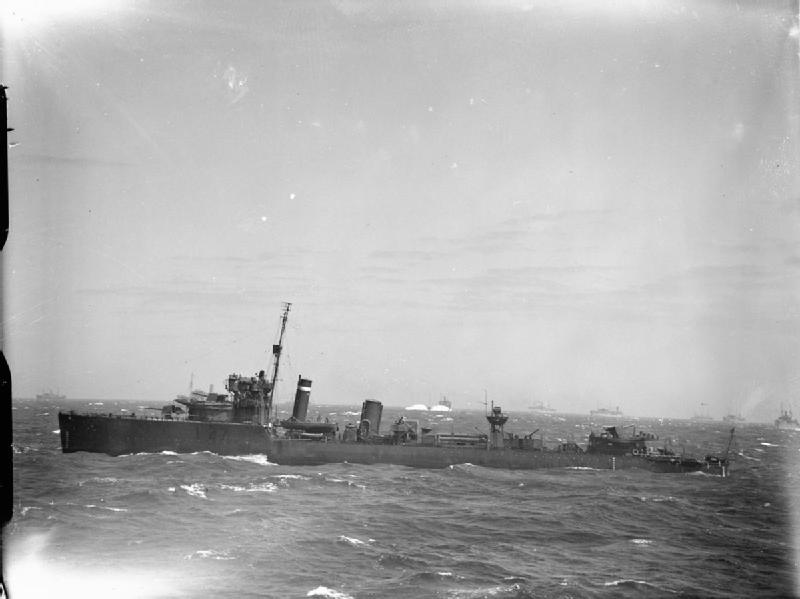
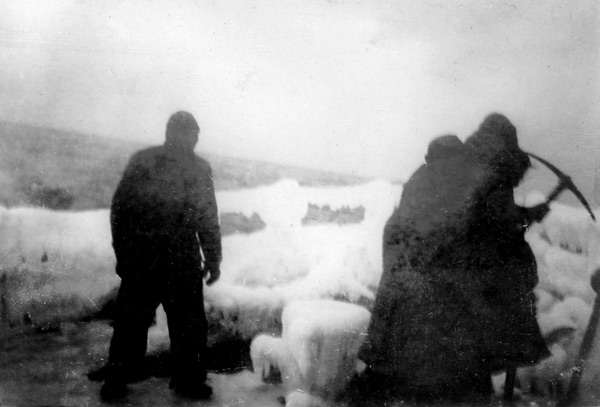
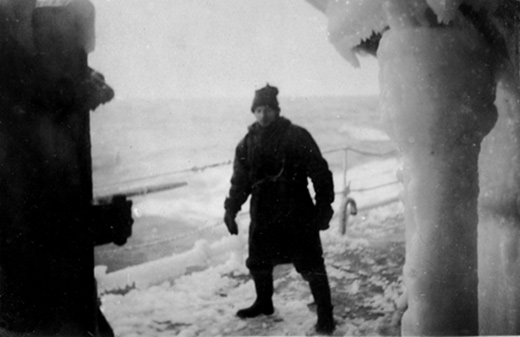
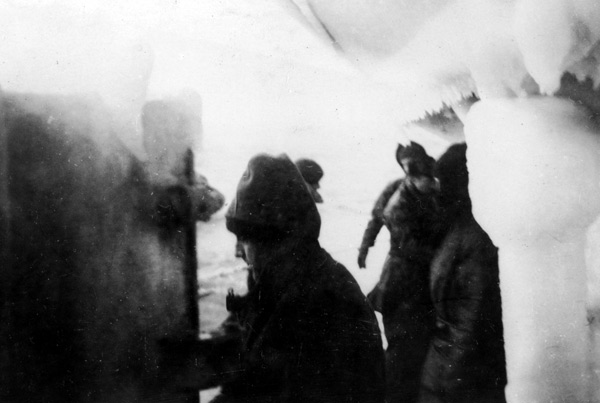
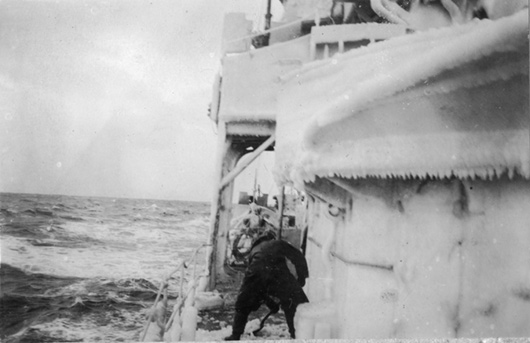
Water
froze on the superstructure, guns, guard rails and focsle and had to be
chipped away to prevent the ship
becoming unstable and capsising. A
safety line with a sling was slung the length of the ship to
make it easier and safer for officers and men going on watch to move
along the icy deck without slipping and being washed overboard. On 27 February, the day before they arrived
at the Kola Inlet at the end of their first convoy to Arctic Russia the Canadian Gunnery Officer failed
to turn
up for the middle watch (0000 - 0400) and was found to have
left the wardroom at the stern, slipped and been washed
overboard on his way to the
bridge. Lt. Stuart W M Farquharson-Roberts RN, the Navigator in HMS Westcott,
describes how this could easily happen when making the the perilous
journey from the officers flat on the quarterdeck at the stern to the
open bridge at the bow in his account of Christmas at sea in HMS Westcott while escorting return convoy RW.55A on 25 December 1943.
Lt James Glossop RN remembers the night well. He was due to go
on watch at 0800 and went to bed at midnight expecting to sleep the
whole night through but was woken at 0400 and asked to relieve the
First Lt who had conducted an unsuccessful search for the missing
officer. Neither Bill Perks or Albert Foulser could remember the name
of the Canadian officer but a search on naval-history.net identified him as Lieutenant
Frederick Victor Robinson RCNVR who was lost, Missing Presumed Killed
(MPK), on 27 February 1944, the day before HMS Walker arrived
at the Kola Inlet. He was a 28 years old former school teacher from London, Ontario, a
city north of Lake Eyrie near the US border. He had volunteered for the
Navy in August 1940 and trained at HMCS Stadacona at Halifax, Nova Scotia, before being sent to Britain for officer training at HMS King Alfred. In June 1941 he was sent on a two months course at HMS Quebec, the No 1 Combined (Operations) Training Centre (No 1 CTC) at Inverary on the remote shores of Loch Fyne in Scotland before being posted to HMS Ferrett,
the shore base for Atlantic escorts at Londonderry where he may have
met his future wife, Elizabeth Wilson from Belfast. She was two years
younger than him, the daughter of a deceased Captain in the Black
Watch. He joined his first real ship, an elderly Town Class destroyer,
HMS Clare, on 5 November 1941 and married Elizabeth at the Registry Office in Islington on 23 February 1942.
During his two years in HMS Clare in 1941-3 she was intially based at Liverpool with the 41st Escort Group for defence of West African convoys but after a refit escorted convoys to Gibraltar and was sent to the Mediterranean and took part in Operation Torch, the landings near Syracuse in Sicily. Lt Frederick V. Robinson RCNVR joined HMS Walker on 13 October 1943 with Sub Lt (E) R.R. Brooks RCNVR when she was part of the 4th Escort Group based at at Londonderry. Frederick Robinson's death was confirmed in a letter from the Canadian Navy Board to his father on 13 April 1944. By the time of his death Elizabeth had a daughter, Patricia Robinson. They were repatriated by the Canadian Navy aboard an elderly liner the SS Letitia in September 1946 and joined her father-in-law, Ernest Walter Robinson, a schoolmaster in London, Ontario.
Return Convoy RA.57
2 - 10 March 1944
Arctic Convoy JW 58
29 March - 4 April
On 29 March 1944, Walker joined Beagle, Boadicea and Keppel of the 8th Escort Group together with the sloops of the 2nd Escort Group – Magpie, Starling (commanded by Cpt Frederic "Johnny" Walker), Whimbrel, Wild Goose, and Wren
provided a strong close escort for Convoy JW58. It came under German
air and submarine attack, but arrived at the Kola Inlet on 4 April. The
senior officer of the combined force was the Rear-Admiral in command of
the cruiser, Diadem, a comparatively new ship and leader of the Tenth Cruiser Squadron. The escort carriers Tracker and Activity provided air cover. The convoy included USS Milwaukee which was being loaned by the US to the Russian Navy.
During this convoy six shadowing aircraft were shot down by aircraft
from the carrier. On the 2nd April carrier aircraft carried out attacks
on submarines causing damage and shooting down a Ju88 aircraft. On the
next day Submarine U288 was sighted and attacked by Swordfish Aircraft
of 819 Squadron. U288 was sunk North of North Cape by rocket attacks
despite intense AA fire and manoeuvers by the submarine to avoid being
hit.
Arctic Convoy JW.58 arrived at the Kola Inlet on 4 April 1944. "Walker Morning News" was received
as naval signals by George Walker, Telegraphist in the Wireless Office,
and posted on the ship's notice board. It was retrieved and kept by AB Donald Frank Wright, an RDF operator in HMS Walker and sent to me by Stephen Wright, his Grandson.
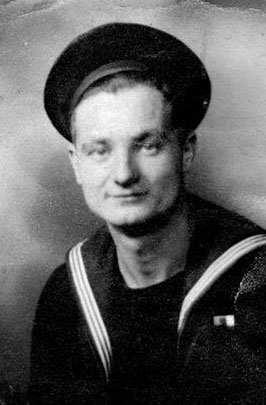 George Walker Telegraphist C/JX220093
Was "Walker Morning News" a pun? HMS Walker was named after Admiral Sir Baldwin Wake Walker (1802–1876) who got the RN to adopt the Ironclad warship. George Walker served in HMS Walker from 27 December 1943 - 9 April 1945 |
Arctic Convoy JW.58 arrived at the Kola Inlet on 4 April 1944
These messages were retained by AB Donald Frank Wright, RDF operator in HMS Walker, June 1943 - Jan 1945 Courtesy of Stephen Wright, his Grandson 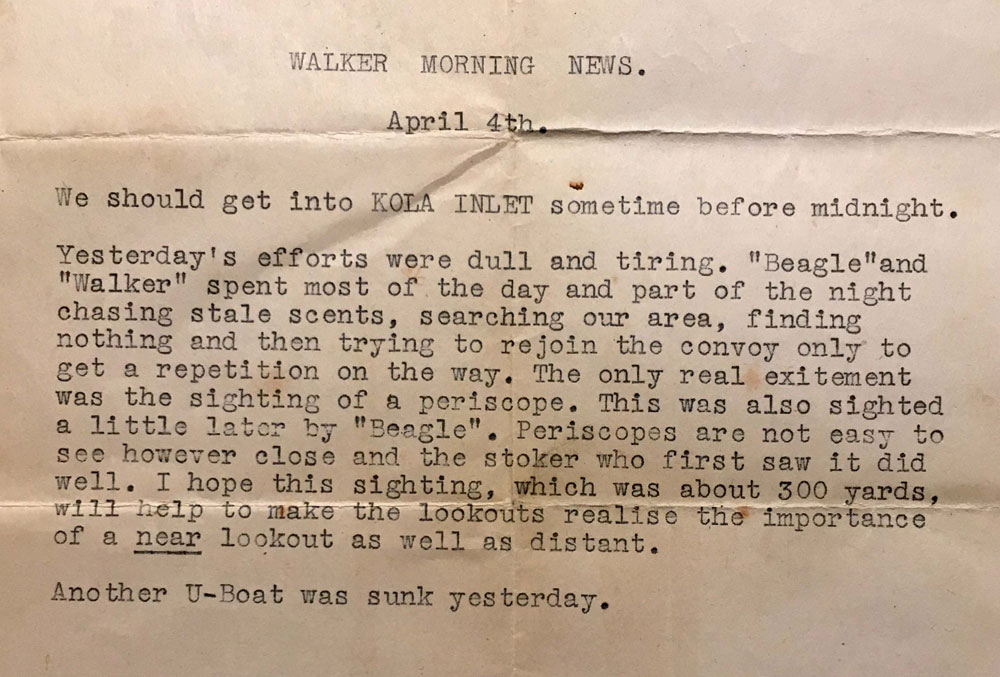 |
 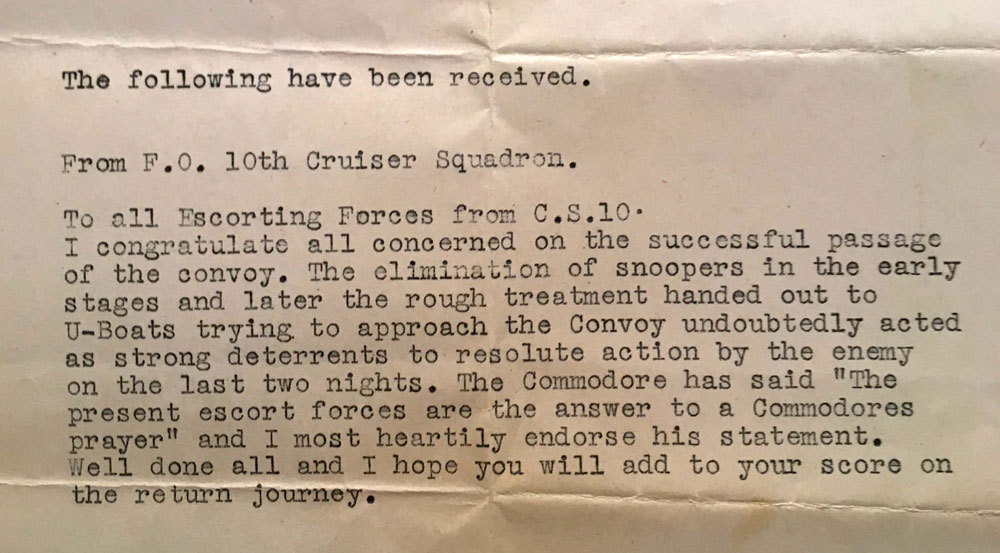 |
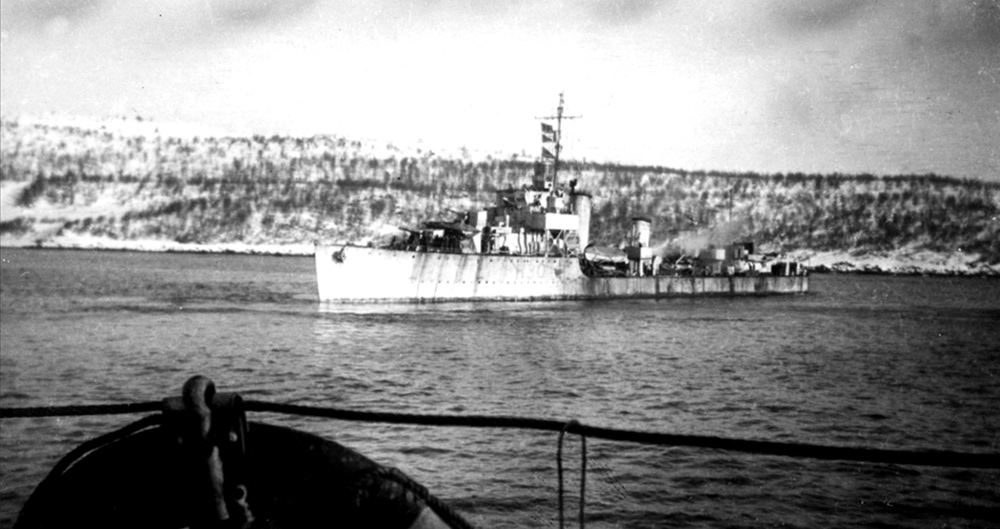
HMS Beagle (H30), a member of the 8th Escort Group, in the Kola inlet near the Russian naval base of Polyanoe
HMS Beagle (H30) and HMS Boadicea (H65) were B-Class destroyers built around 1930 which together with the V & W Class Leader HMS Keppell and HMS Walker made up the 8th Escort Group in 1944
HMS Boadicea, commanded by Lt. Frederick William Hawkins RN, a former CO of HMS Woolston, was torpedoed and sunk two months later on 13 June 1944 during the Normandy landings
Courtesy of Albert Foulser
Return Convoy RA.58
7 - 12 April 1944
Walker and the 8th Escort Group and the return convoy of 36 empty ships left the Kola Inlet on 7 April but the enemy did not learn of their departure until the following day. Ten u-boats attempted to block the passage between Bear Island and North Cape but the Convooy passed south of their patrol line, escaped unnoticed and returned to Loch Ewe without loss.
Operation FZ
20 - 23 April 1944
The
supply route to the USSR had switched to the "Persian Corridor" to
Azerbaijan via the Persian Gulf and Iran for the Summer months but
although there were no more ships waiting to be escorted north there
were empty ships in Russian ports waiting to be escorted south. In
addition, the crew of the USS Milwaukee were waiting for a lift home and the Russian crew of the Battleship, Royal Sovereign, which was being transferred to the USSR, needed taking to Britain (Operation FZ). She would be renamed Archangelsk.
A strong escort force including the Activity, Diadem, Fencer,
14 Home Fleet Destroyers and 4 Canadian Frigates attached to the Home
Fleet headed North to bring back the empty ships. The troop ship, TSS Nea Hellas,
was taking passage to embark the Russian and USN crew members but
mechanical defects forced her to turn back and they had to be
accomodated on the merchant ships and warships. The Convoy reached the Kola Inlet unobserved on 23 April.
On
the day of his arrival at Vaenga on the Kola Inlet Rear Admiral R.R.
McGrigor commanding the 1st Cruiser Squadron along with the CO of the
escort carrier Diadem, Captain
D and the SBNO attended a party given by the CiC of the Northern Fleet,
Admiral Levenchenko, and on the day of his departure he invited the CiC
and a number of Russian officers to lunch but "the CiC did not attend
either function on a plea of urgent business with Commissars from
Moscow, his Chief of Staff deputising for him".
Return Convoy RA.59
28 April - 6/7 May 1944
Admiral Levchenko and his staff were riding in the escort carrier HMS Fencer to take command of the USSR's new battleship, Archangelsk. There
were some 2,300 "passengers" distributed between the 43 merchant ships
and the 23 escorts in the return convoy. The numbers aboard each of the
merchant ships are given in brackets in the plan of the convoy below.
RA.59 was routed as far north as possible, the actual
track being limited by the ice edge. At 2000 on the 30th April 1944,
when the Convoy was 50 miles south of Bear Island, the United States
Liberty ship William S Thayer, third ship in the third column (see warsailors.com below), which
was carrying 164 Russian and American personnel was torpedoed. Whitehall and HMS Inconstant swept up the port side of the convoy and then joined HMS Boadicea hunting a contact on the port quarter of the convoy.
The dedicated rescue boat, the Liberty Ship SS Robert Eden, reported that there were many men in the water and that the bow section had sunk. William Chisholm, an engine cadet on the Robert Eden,
described his part in the rescue: "I ended up in a motorized life boat.
A sea painter wrapped around the propeller and we couldn’t use the
motor. The crew was forced to row. Being from Gloucester, Massachusetts
I could handle the oar. We rowed over to the aft section of the Thayer and boarded a number of the crew. The rest returned to the Eden with survivors."
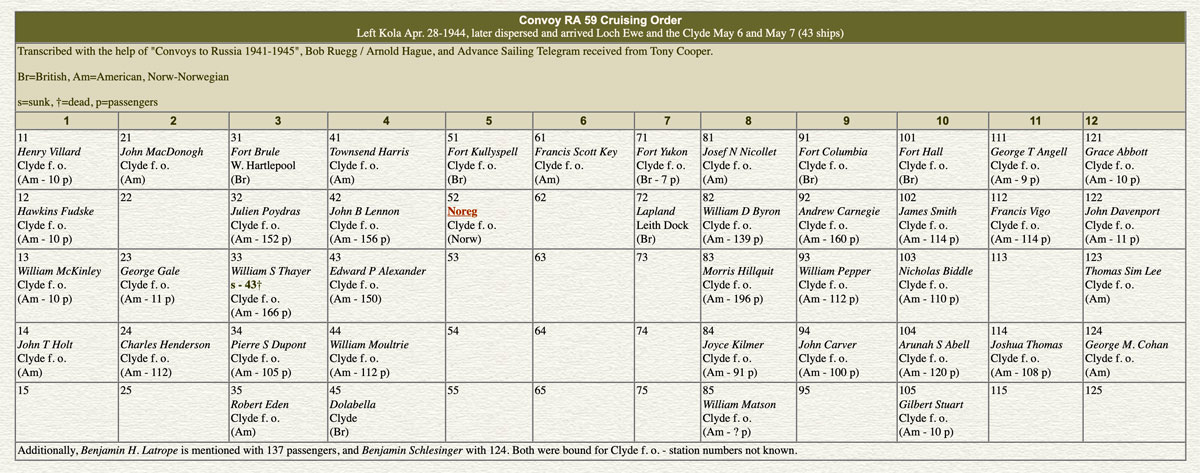
Meanwhile Walker joined Keppel searching for the attacking u-boat in the vicinity of the wreck (Operation Observant). At 2107 Whitehall
was ordered to close and pick up survivors. As the after part did not
appear to be in any danger of sinking it was decided to rescue men from
the water first. Whitehall proceeded to windward of rafts and wreckage, all floating in thick oil. The whaler was lowered and Whitehall went alongside the rafts. Twelve men were rescued, and the whaler returned with 10 more.
Boadicea joined Walker alongside the wreck. Boadicea lowered a boat and also embarked some survivors over her bows on the lee side. Walker
went alongside on the weather side and embarked the remaining 49
survivors, in about 4 minutes with little difficulty. All were
Russians. Walker and Boadicea were ordered to sink the derelict. Boadicea set it on fire with gunfire, while Walker
steamed past and lobbed two depth charges from the Port Throwers set
shallow. A beautiful straddle was achieved and the wreck sank a few
minutes later.
Click on the links to read Lt Cdr A.N. Rowell's Report of Proceedings and the Report of Proceedings by the CO of HMS Whitehall. Admiral Levchenko and his staff were riding in the escort carrier HMS Fencer to take command of the USSR's new battleship, Archangelsk. He requested that the ships assisting in the rescue of survivors from the William S Thayer telegraph the number of Russians saved. Walker's ROP includes the log of signals received in reponse to this request: Walker rescued 49, Whitehall 6 named survivors (plus two dead) and the rescue ship, Robert Eden, 34 making a total of 89 saved plus those who died after rescue and were buried at sea. In addition Whitehall rescued 10 Americans (plus four who died) and the Robert Eden 29 plus 4 who died.
The
most accurate figures are probably those in "The names of those lost from the personnel of the ship squadrons of the
Northern Fleet" issued by the Staff of the Ship Squadrons of the
Northern Fleet on 16 September 1944, Ref No 011P Vaenga. This document
gives the names of 23 who died out of the 164 Russian crew members known to be on the William S Thayer.
It was standard practice in both Navies to record the names of those
who died so that their families could be notified but less
common to record the names of those saved and returned to their units. We have been contacted by
the grandson of Snr Lt Valentin Aleksandrovich Martinov, a submariner, who
died from exposure soon after his rescue by HMS Whitehall and shall be telling his story on the website of HMS Whitehall. We are hoping to hear from the families of some of the other Russian sailors aboard the William S Thayer
when she was sunk. If a member of your family is on this list or you
recognise one of the men in Albert Foulser's photographs you can e-mail
details in Russian to his grandson, Alexander Kovalev.
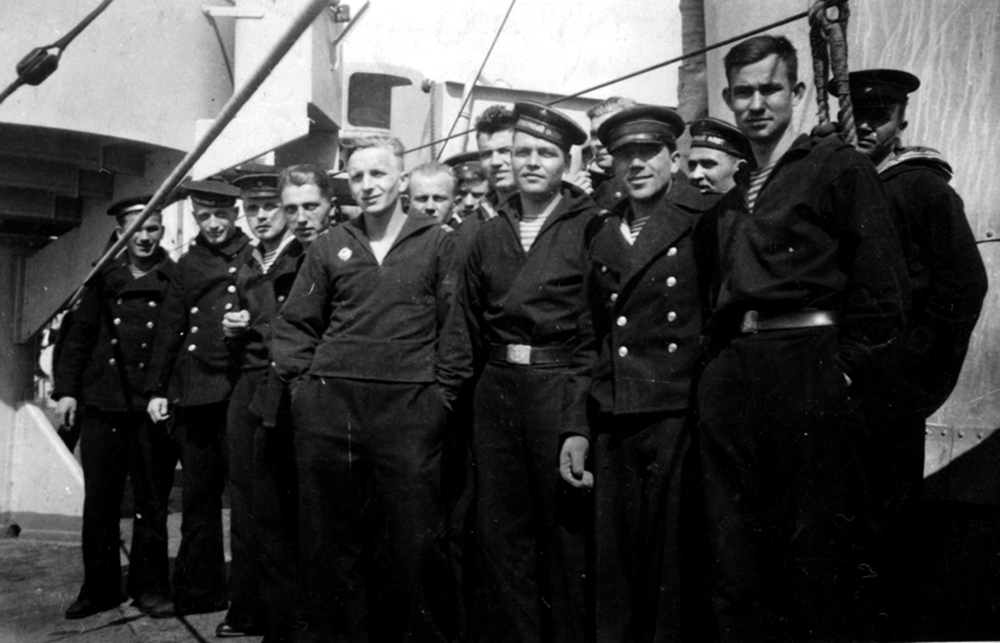
Lt James Glossop had an amusing memory of the Russians rescued when the William S Thayer was torpedoed. One
of them, a large, overbearing fellow with a big boozer’s nose, was
never in uniform. He was less well educated than the others and not at
all comfortable at sea but was rumoured to be a master chess player.
The Ward Room arranged for six of its chess players to play against
him. The agreement was that he would be blindfolded and the six players
from HMS Walker would have their moves described and translated to the blindfolded Russian. Within 12-15 moves he had demolished four of the Walker team. The other two, including James Glossop, were saved when the rattles sounded an anti-sub alarm.
The friendly relations between the Russians rescued from the William S Thayer and the officers and men of HMS Walker did not last. James Glossop recalled that on Arctic Convoy JW.59, the first convoy back to the USSR after D Day, Walker escorted the Royal Sovereign now renamed Arkhangelsk to Murmansk. Even though Walker had played a crucial role in getting part of her crew to the UK, there was no cordiality in signals or chatter from the Archangelsk to Walker during the voyage.
On another convoy the stanchions above the
focastle were washed away
and mess deck badly damaged and they went into Iceland where the Mess
Deck was
shored up with timber instead of being repaired.
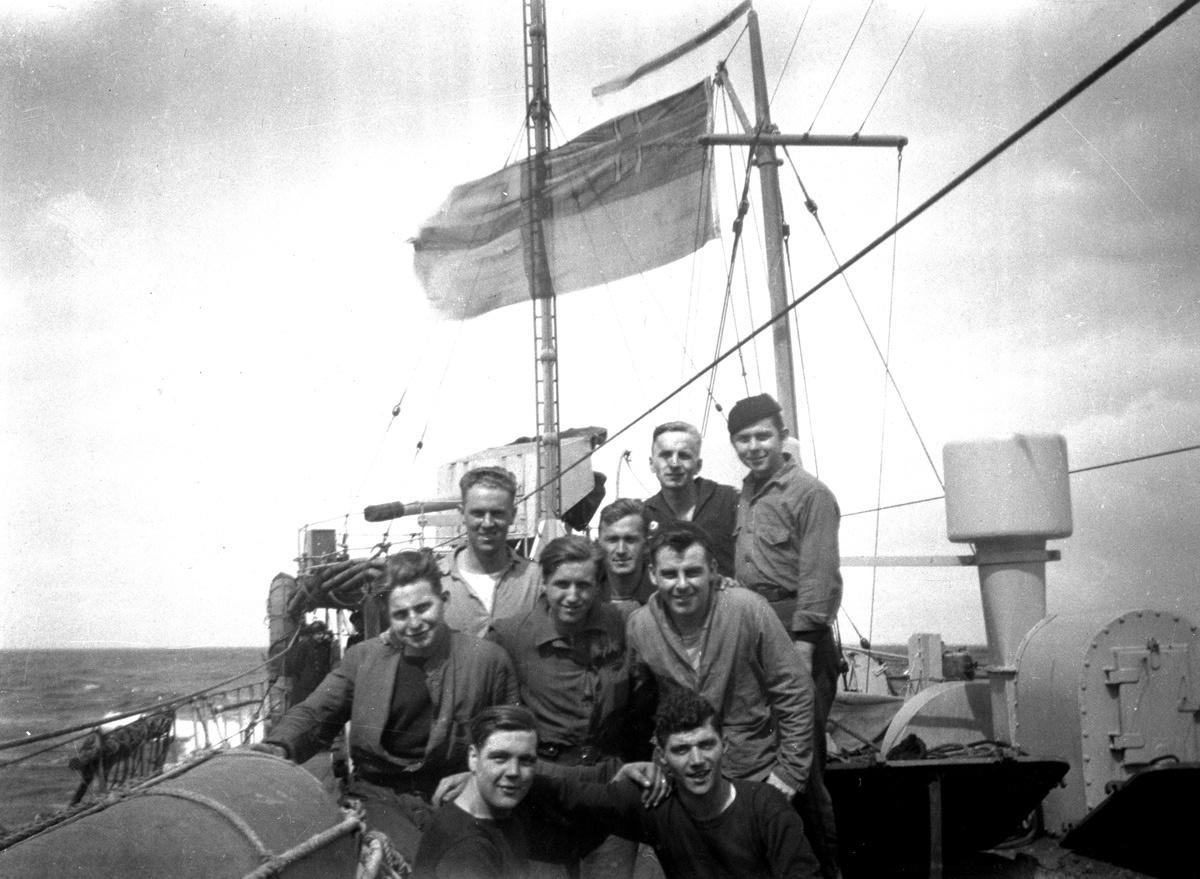
Albert Foulser is on the left in this photograph of his shipmates in HMS Walker with USN sailors taking passage to Britain and Russians rescued from the William S Thayer
This photograph was taken on Kodak 620 film in Albert Foulser's box
Brownie camera and the image has been scanned from the negative
carefully kept by Albert
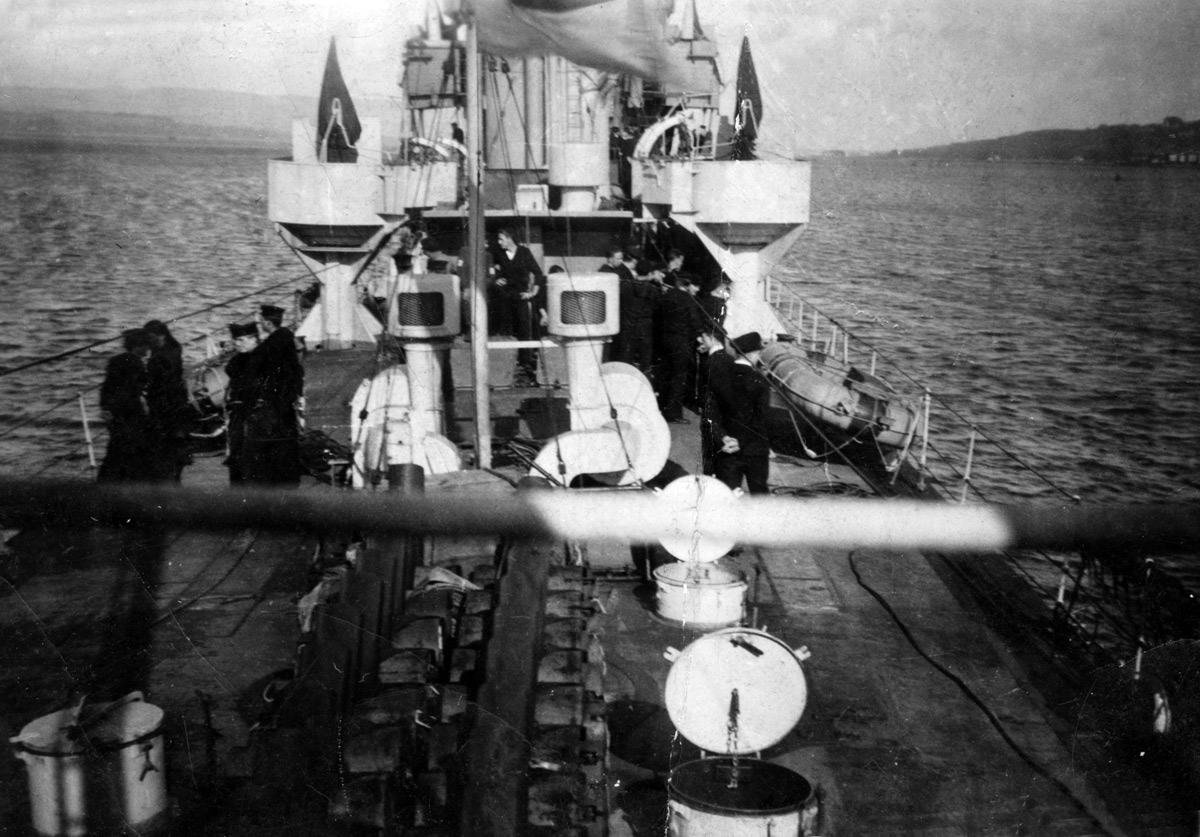
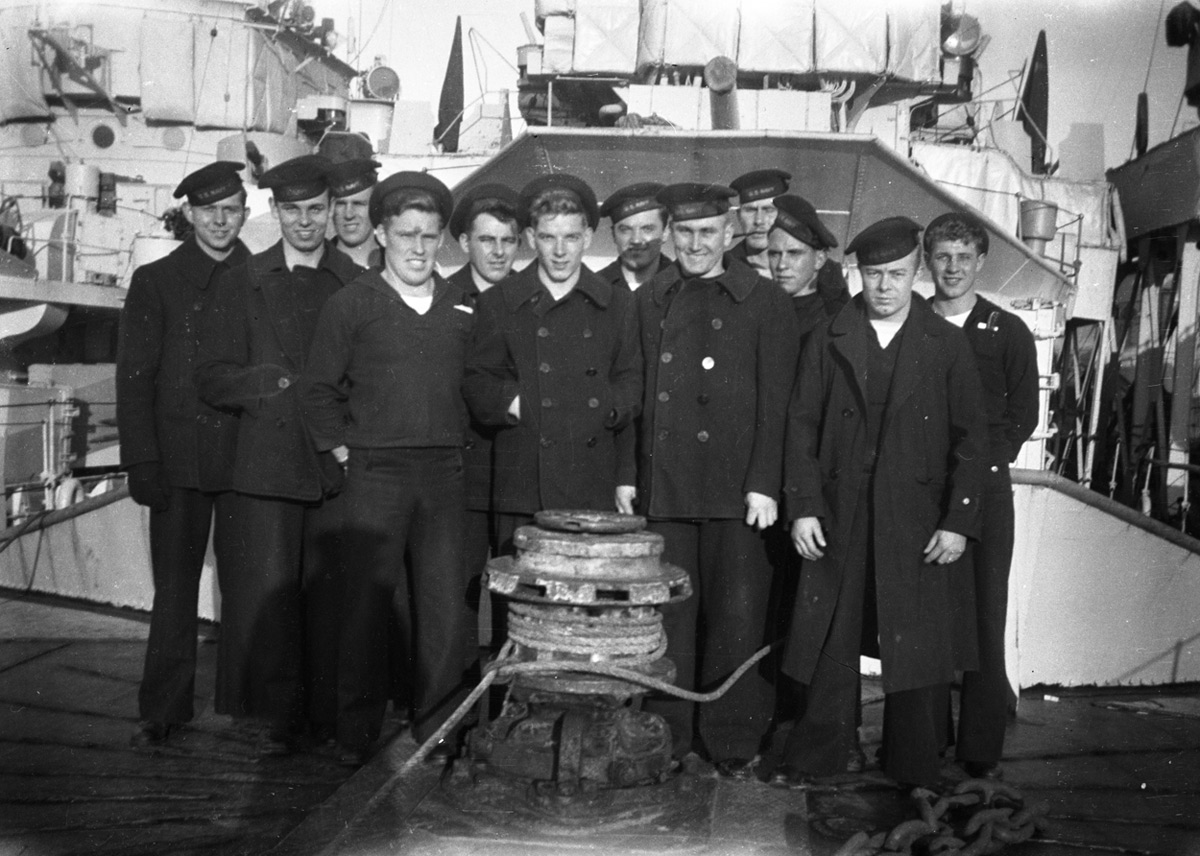
Some
of the USN sailors who crewed the USS Milwaukee on her voyage north to
Murmansk (Operation FZ) in April 1944 and returned to Britain aboard
HMS Walker
They are easily identifiable by their USN peacoats and the USN tally on their caps and were photographed on arrival at Greenock by Albert Foulser
Please let us know if you recognise a mermber of your family in this group
HMS Walker escorted convoys
from Milford Haven to the D-Day beaches in June but returned to escorting Arctic Convoys in August
Arctic Convoy JW.59
15 – 24 August 1944
Vice Admiral F.H.G. Dalrymple-Hamilton was the senior officer in the Convoy flew his flag in the escort carrier Vindex. Enemy aircraft located the Convoy on 20 August and U-344 sank the Sloop Kite with only 9 out of the crew of nearly 200 saved but Swordfish aircraft from Vindex gained revenge by sinking the u-boat the following day. Two days later ships of the 20th Escort Group sunk U-354 which had earlier that day sunk the frigate HMS Bickerton commanded by Walker’s former CO, Donald Macintyre, and badly damaged the escort carrier Nabob. An abortive attack was made on Archangelsk by U-711 but the flagship of the Northern Fleet with Admiral Levchenko in command and all the merchant ships in JW.59 arrived safely at the Kola Inlet on 24 August 1944.
Bill Forster recorded an interview with
Bill Perks at Eastbourne in
2014 and Albert Foulser (Reel 2) at St Ives in 2016
They cover similar ground but Bill Perks gives a clearer account than Albert's
You can click on the links to hear them describe their wartime service on HMS Walker
be patient - it takes a couple of
minutes before the file opens and they start speaking
See more of the photographs taken by Albert Foulser aboard HMS Walker on his 5/- box Brownie camera
and at 10 Downing Street with Prime Minister Tony Blair in 2005
Arctic Convoys 2: Lt Cdr Tony Trew SANF(V) as CO
HMS Walker resumed escorting Arctic Convoys from October 1944 until January 1945 under a new CO, Lt Cdr A.F. Trew SANF(V).